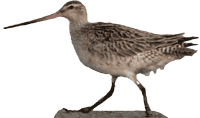- Home
- About S&T
- Taxa/Organisms
- Ecosystems
- Issues
- Methods & Tools
- Reports & Publications
- Location
- Search
November 2007 | Publisher: Academic Institution (Sage-grouse Restoration Project (SGRP), Utah State University) | Format: .PDF
sgrp.usu.edu — The greater sage-grouse (Centrocercus urophasianus) and the Gunnison sage-grouse (C. minimus) are species of concern because of their population declines and shrinking geographic distributions. Of continuing interest is the question of population abundance and trends. This publication answers the questions that deal with sage-grouse population, More...

2007 | Publisher: USGS | Format: URL
pubs.usgs.gov — The Southwestern Willow Flycatcher (Empidonax traillii extimus) is an endangered bird that breeds only in dense riparian habitats in six southwestern states (southern California, extreme southern Nevada, southern Utah, southwestern Colorado, Arizona, and New Mexico). This report synthesizes information on all known Southwestern Willow Flycatcher More...

April 15 2004 | Publisher: Other Federal Agency (United States Fish and Wildlife Service (USFWS)) | Format: .PDF
www.fws.gov — Case study presented at the Department of Interior Workshop on Adaptive Management of the successful use of adaptive management for the regulation of the North American waterfowl harvest, which has reduced contentiousness in rule-making using a transparent and inclusive process, provided maximum hunting opportunity using a framework for More...

2001 | Publisher: USGS | Science Center: Upper Midwest Environmental Sciences Center (UMESC, LaCrosse) | Format: URL
www.umesc.usgs.gov — Research at the Upper Midwest Environmental Center, which gathered detailed observations on tree swallow nesting success and contaminant concentrations in 1998-2000, to guide EPA and the U.S. Fish and Wildlife Service in effectively managing the risk of chemical contaminants to wildlife and the environment.

Publisher: USGS | Science Center: Forest and Rangeland Ecosystem Science Center (FRESC, Corvallis) | Format: URL
fresc.usgs.gov — Conservation Genetics of Shorebirds uses molecular techniques to describe genetic structure and diversity in North American shorebirds (order: Charadriiformes) to facilitate population maintenance and recovery of these migratory birds.

Publisher: USGS | Science Center: Patuxent Wildlife Research Center (PWRC, Laurel) | Format: URL
www.mbr-pwrc.usgs.gov — Procedures for collection, analysis, and display of data collected at several geographic scales for migratory bird research at the Patuxent Wildlife Research Center is designed to provide regional estimates of relative abundance for mapping and other uses. This website links to a specific protocol for conducting bird counts, as well as color maps More...

Publisher: Other (American Bird Conservancy (ABC)) | Format: URL
www.abcbirds.org — he Avian Incident Monitoring System (AIMS) is a cooperative program between American Bird Conservancy (ABC) and the US Environmental Protection Agency (EPA). Through AIMS, ABC is implementing programs dedicated to data collection, storage and presentation, and programs dedicated to improving identification, investigation, and laboratory analysis More...

Publisher: USGS | Science Center: Alaska Science Center (ASC, Anchorage) | Format: URL
alaska.usgs.gov — This web resource provides information concerning the on-going Research at the USGS Alaska Science Center on birds and avian influenza (bird flu). The site links to quick facts, on-going research, workshop results, monitoring and surveillance, guidelines on how to safeguard against avian influenza, publications and reports, migratory bird More...

Publisher: Other (Bird Studies Canada (Etudes d'Oiseaux Canada)) | Format: URL
www.bsc-eoc.org — The Canadian Migration Monitoring Network has 21 monitoring stations across Canada where migrating birds are tracked from the Atlantic to the Pacific. This website aids in providing much needed baseline data on population trends of northern breeding birds by developing standards for data collection, preparing computer software to aid with data More...

Publisher: USGS | Science Center: Fort Collins Science Center (FORT, Ft. Collins) | Format: URL
www.fort.usgs.gov — The Arizona Grasshopper Sparrow (Ammodramus savannarum ammolegus) breeds in desert grasslands of southeastern Arizona and southwestern New Mexico in the US, and in adjacent parts of northern Sonora and Chihuahua, Mexico. Roads that were surveyed in 1982 and 1987 in Arizona and New Mexico were relocated and roadside survey protocols were repeated More...

Publisher: USGS | Format: URL
pubs.er.usgs.gov — This report presents the results of the 2006 International Census of Piping Plovers (Charadrius melodus). Two sets of tabular data are reported: one for distribution and abundance of wintering Piping Plovers, the other for distribution and abundance of breeding Piping Plovers. The winter census resulted in the observation of 3,884 Piping Plovers More...

Publisher: USGS | Science Center: Alaska Science Center (ASC, Anchorage) | Format: URL
alaska.usgs.gov — It is estimated that 100,000-150,000 Bar-tailed Godwits breed in Alaska. Under the US Shorebird Conservation Plan, they are a species of High Concern mainly due to their small population size, threats to their non-breeding grounds (especially at migratory stopover sites in Asia), and their relatively restricted breeding distribution within the More...
